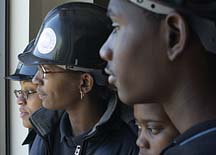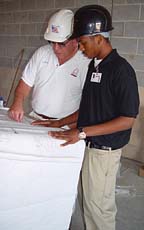
Between history lessons and algebra exams, students at the center are also learning everything they need to know about the construction industry. They are getting a healthy dose of hands-on experience in activities ranging from carpentry to bricklaying, sheet metal work, and a variety of piping and plumbing applications.
The school was started three years ago by the St. Louis chapter of the Associated General Contractors (AGC). Members of the chapter noticed a definite shortage of young people choosing construction careers in the area, and they felt public schools did little to encourage students to explore career opportunities in the trades. AGC decided to take matters into its own hands. That decision was the impetus behind the creation of the first charter high school to emphasize the construction industry.
The school will have its first graduating class in 2005, and so far AGC is proud of the results that have come from the hard work and dedication that went into the development of the program. In fact, the national AGC believes that charter programs such as the one in St. Louis could be the solution for contractors looking to find a new pool of qualified employees. While HVAC courses are not yet part of the curriculum, contractors and school officials are exploring the possibility of adding them in the future.

The Charter Solution
For the HVAC industry and other construction-related trades, the worker shortage is one of the top challenges facing businesses today. The shortage of qualified workers has been acutely felt in the St. Louis area.Len Toenjes, president of the AGC St. Louis chapter, said that during the organization's strategic planning meeting in 1999, many members expressed concern about the lack of qualified employees. They also pointed to the small percentage of minorities and women involved in the construction industry.
Toenjes said that methods of securing workers that had been successful in the past, such as appealing to high school counselors and supporting high school vocational programs, were not working. In fact, he said that only 30 students in metro St. Louis graduated from a high school vocational program in the past year.
With these kinds of difficulties, some AGC members suggested starting their own school. At first, the idea seemed destined to remain just that - an idea. It was placed on the back burner, but it didn't stay there long. "The more we investigated it, the more sense it made," said Toenjes.

Rick Grebel, owner of KCI Construction, is president of the school board for the Construction Careers Center. He explained that the board looks over the operation and direction of the school, while the educational foundation works to secure donations and financial support.
The school was approved in 2001, much faster than anyone thought possible. But the challenges are not over yet.
"This is not a short-term commitment," said Grebel. "You need to be in it for the long haul."
Setting up the school and recruiting students was a challenge for the AGC, but according to Grebel it wasn't the organization's biggest obstacle.

The message that AGC was sending appealed to young people and their parents. The real challenge, according to Grebel, has been dealing with some students and helping them to conform to the school's guidelines.
"We have pretty stringent disciplinary procedures," said Grebel. "We lose a lot of students over that."
He explained that since the school is a charter program, it has more flexibility in setting its own rules. One rule in place at the center is that students must wear a uniform. All students must look professional. Khaki pants and a black polo shirt are mandatory. Students can get detention for not having their shirt tucked in.
Grebel also said that the school has its own procedure for suspensions. Suspended students are kept in school and are required to meet with an ex-military officer on staff at the high school. The officer gives students work to do around the building, which can include cleaning hallways or classrooms.

The school has a "three strikes policy" regarding behavioral in-fractions. After three incidents, a student must attend a meeting with teachers and the student's parents. In most cases, Grebel said, the parents admit they did not realize their son or daughter was causing problems. Many of these students turn themselves around and become more willing to learn and follow the rules.
Lanette Meyer, administrator for the center, detailed the school's admissions policy. She said that students are required to fill out an application and go through an interview process before they are accepted. Meyer believes this helps to determine which students are really interested in a construction career. She explained that it is more important to have a smaller group of interested students than a larger group that includes students that will burn out on the curriculum.
Meyer also said that once admitted to the program, students are treated like workers on a jobsite or at a construction firm.
"We have them working a lot on their work ethic," she said.
This includes introducing them to the soft skills that will be necessary once they are in the construction trade. In another move patterned after businesses in the construction industry, Meyer said that every student must also go through drug testing.

Real-World Applications
Meyer said that it is important that the students realize how the trades impact many parts of everyday life."Each teacher relates math to construction or how unions have fit into history," she said. "We try to show them the applicability of what they are doing."
She also stressed the importance of exposing students to the big picture of the construction industry and its related trades. Students not only learn about construction and carpentry, they are exposed to the mechanical trades, including engineering, plumbing, pipefitting, and some refrigeration applications.
The local Plumbing Industry Council (PIC), along with the Plumbers and Pipefitters' Local 562, recently helped to educate the students at the center about other trade possibilities.
During a three-week program called "Explore and Discover Your Options with PIC," a number of students were able to learn about plumbing and pipefitting.

"The Plumbing Industry Council is the first trade association that has stepped up to provide this hands-on instruction for young people," said Meyer. "They said, ‘We're here and ready to go.' I hope this is the step that will encourage other trade associations to develop a partnership with us."
During the three-week program, students were transported to the Local 562 apprenticeship training center, where they attended classes conducted by apprenticeship training instructors.
During the first week of classes, students focused exclusively on pipefitting. In the second and third weeks of the course, students were introduced to plumbing applications.
According to Sweet, the pipefitting portion of the program looked at several different piping applications, including refrigerant piping. Students also learned about job safety and how to use basic materials and tools. The course included field trips. Students visited a hospital and were able to see union plumbers and pipefitters in action.
When all is said and done, Sweet said that he would like to see two things happen. Of course, he would like to see a few of the students choose a mechanical trade when they graduate from the center. He'd also like to see even more trades and associations get involved with this school and in the development of other such programs across the country.

More To Come
AGC of St. Louis has been fortunate to get a great deal of support for the Construction Careers Center. Besides the support given by PCI to provide mechanical training, many local contractors and businesses have helped in other ways.Meyer said that the school recently completed a 5,000-square-foot addition, which will provide more shop space for students. The addition was made possible by over $5 million in donations from St. Louis contractors. She also said that a number of tools were donated for use in the new shop.
Meyer said that the Construction Careers Center was the first charter high school to focus on the construction trade, but it is not the only educational institution of its kind. There are a handful of construction academies across the country, and some construction leaders are getting involved with their local high schools in order to introduce students to the construction trades.
For example, in Chattanooga, Tenn., members of the East Tennessee chapter of AGC have created a program at East Ridge High School. The program got its start in the fall of 2002 and is completely funded by the local construction industry. Students can choose whether they want to take a traditional college prep course or pursue the vocational education path.
This is just the beginning, according to AGC. Dennis Day, representative for the national AGC chapter, noted that the association has spent a great deal of time and money in trying to recruit and educate young people about the construction trades. With the success of the St. Louis charter school, AGC has found another outlet to help the association accomplish its goal.
"Part of the overall picture is to have a pool of individuals to hire from," said Day.
He explained that charter schools and construction programs are just one piece of the puzzle. For example, AGC is working with the Department of Labor to obtain grant money that would make it possible for AGC to adopt additional high schools and introduce the construction industry to more prospective students.
For more information, visit www.agc.org.
Publication date: 01/19/2004


Report Abusive Comment